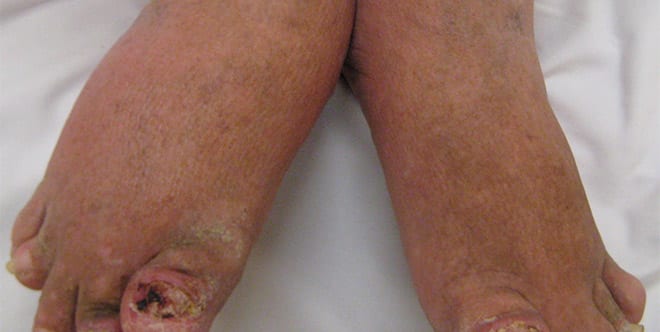When the skin shows the first symptoms
Psoriatic arthritis is a form of arthritis (inflammation of the joints) that can occur in people who have the skin condition psoriasis.. Psoriasis is a common condition characterised by red and white, scaly patches on the skin. Psoriatic arthritis can affect any joint in the body, including the spine.

Anyone can be affected by psoriatic arthritisbut it is more common in Caucasians than in African Americans or Asian Americans. It most often appears between the ages of 30 and 50, but can also begin in childhood. Ten to 20 percent of people with psoriasis eventually develop psoriatic arthritis. Typically, the skin disease precedes the arthritis, sometimes by several years. However, in some cases, arthritic symptoms appear first.
The cause of psoriatic arthritis is not known; however, doctors believe that a combination of genetic and environmental factors is involved. Research shows that people with psoriatic arthritis often have a family member with psoriasis or arthritis. In people who are susceptible, an infection can activate the immune system, triggering the development of psoriatic arthritis.
Psoriatic arthritis affects both the skin and the musculoskeletal system. The most commonly affected joints are the distal joints (those closest to the nail) of the fingers or toes, as well as the wrists, knees, ankles and lower back.
The skin symptoms may include:
- Thickening and reddening of the skin with scaly, silvery-white patches called scales.
- Nail pitting or separation of the nail.
The diagnosis The diagnosis of psoriatic arthritis is made on the basis of findings from a medical and family history and physical examination, as well as X-rays or magnetic resonance imaging (MRI) of the affected joints. Although there is no laboratory test to diagnose psoriatic arthritis, the doctor may order blood or joint fluid tests to rule out other forms of arthritis with similar symptoms. Early diagnosis and treatment of psoriatic arthritis can help prevent irreparable joint damage.
Research on psoriatic arthritis
Researchers are conducting research that will eventually improve the understanding and outcomes of psoriatic arthritis.
Some promising areas of research include:
- Genetics. US scientists supported by the National Institute of Arthritis and Musculoskeletal and Skin Diseases (NIAMS) are working to discover the genes associated with psoriasis, as well as modifier genes that may indicate that psoriasis is a disease of the skin. people with psoriasis are also at risk of psoriatic arthritis. Identifying genes that increase the risk of psoriatic arthritis will help scientists unlock the secrets of this troubling disease, and identify targets for more specific and effective therapy.
- Biological therapies. Biological therapies that block the cytokines inflammatory TNF (TNF cytokines refer to a group of cytokines whose family can cause cell death or apoptosis, constituting tumour necrosis factors). have proven to be one of the most effective treatments for psoriatic arthritis.. A number of other biologic agents are currently in clinical trials in psoriatic arthritis, and researchers continue to seek biologic therapy targets for the disease.
- The role of vitamin D. A recent study has shown that vitamin D insufficiency is common in people with psoriatic arthritis. A new NIAMS-supported study is designed to investigate the effects of vitamin D supplementation, in addition to omega-3 marine fatty acids and docosahexaenoic acid (DHA), on incidence, inflammation and chronic pain in autoimmune diseases such as psoriatic arthritis.
- Risk factors. To better understand what causes psoriatic arthritis, with the ultimate goal of stopping it from developing, scientists are studying factors that predict the risk of arthritis in people with psoriasis. A recent study found that people with psoriasis who reported being obese at age 18 were more likely to develop arthritis and develop it at a younger age than people with a normal body mass index (BMI). Other research has shown that more severe skin disease is a predictor of an increased risk of joint disease.
- Diagnostics. The similarity between psoriatic arthritis and other forms of inflammatory arthritis can delay an accurate diagnosis, particularly when the arthritis precedes the skin disease.. A group of researchers looking for better ways to diagnose the disease have found that a technique called magnetic resonance imaging with contrast may help doctors differentiate between rheumatoid arthritis and psoriatic arthritis in the hand and wrist, allowing them to target therapies for each condition.
Natural treatment for psoriatic arthritis
At Biosalud, we deal first and foremost with the psoriasis for what it is, a autoimmune disease, in which the immune system becomes the aggressor and attacks parts of the body instead of protecting it, in this case the skin.
We will analyse the individual's genetic factors that predispose them to develop psoriasis and the environmental factors in their body that produced the disease, in order to subsequently deactivate those genes that have been activated. And if the disease is not too advanced, we can bring it back under control.
If the psoriasis has broken out in a psoriatic arthritisThe remedy will vary, depending on the specific case. But we have regenerative medicine treatments that can even help us to regenerate the affected organ.
We are experts in regenerative medicine. In fact, we have set up a medical unit specialised in this area.
We leave you this video in which Mariano Bueno explains to you in a general and practical way how to use the joint regeneration treatments.


